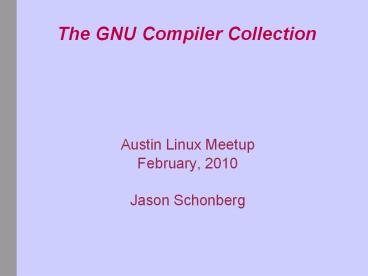The%20GNU%20Compiler%20Collection - PowerPoint PPT Presentation
Title:
The%20GNU%20Compiler%20Collection
Description:
A little computer history For those who may not remember what a vax looks like . . . II. ... Consult the gcc man page for additional information. – PowerPoint PPT presentation
Number of Views:193
Avg rating:3.0/5.0
Title: The%20GNU%20Compiler%20Collection
1
The GNU Compiler Collection
- Austin Linux Meetup
- February, 2010
- Jason Schonberg
2
Overview
- What is a Compiler?
- Why use a Compiler?
- Did the Compiler do a good job?
- What else can a Compiler do for me?
3
I. What is a Compiler?
- A Compiler is a computer program that
- translates a high level language into
- machine code.
4
A short example using C
5
The GNU Compiler Collection Supports Many
Programming Languages
- C
- C
- Ada
- Java
- Pascal
- Fortran
6
The GNU Compiler Collection Supports Multiple
Architectures
- Mips, Alpha, Sparc, X86, X86-64, Itanium,
PowerPC, Motorola 68K, Motorola 68HC11, Vax - And many more . . .
7
A little computer history
- For those who may not remember what a vax looks
like . . .
System introduced in 1977 VAX the Virtual
Address eXtension of the PDP-11's 16-bit
architecture to a 32 bit architecture
8
II. Why Use a Compiler?
- The alternative is to write in a low level
- language such as assembly or machine
- code. That's tedious, non-portable,
- error-prone and not practical for applications
- of any significant size.
9
Compiler Flow
- 1) Parse human provided code
- 2) Translate to RTL
- 3) Optimize
- 4) Link to resolve references to external
- library calls
- 5) Generate machine code
10
Let's Consider Another Example
11
Let's see what the compiler did
12
(No Transcript)
13
Try again with higher optimization
14
(No Transcript)
15
Let's Consider A third Example
16
(No Transcript)
17
46 c7 04 24 01 00 00 00 movl
0x1,(esp) 4d 89 44 24 08 mov
eax,0x8(esp) 51 e8 fc ff ff ff call
52 ltmain0x52gt 56 83 c4 24 add
0x24,esp 59 31 c0 xor
eax,eax 5b 59 pop
ecx 5c 5d pop ebp
5d 8d 61 fc lea
-0x4(ecx),esp 60 c3 ret
18
What else can the compiler do?
- Use the -g flag and the compiler will introduce
additional debugging information. - This is useful if you are trying to determine
what's happening in misbehaving code. - Also useful with tools such as Valgrind.
19
www.valgrind.org
20
Other useful flags
- -finline-functions
- create local copies of simple functions instead
of making a function call. - -funroll-loops
- unroll those loops whose iteration count can be
- determined at compile time
- -fstack-protector
- emit extra code to check for buffer overflows
such as stack smashing attacks.
21
- -ftest-coverage
- Create a side file for use with gcov.
- -pg
- Compile with code profiling to have the system
- determine where most of your run time is being
spent. - -ansi
- Compile with the ISO C90 standard
- -static
- On those systems that support it, build with
static libraries
22
- There are 100s of additional flags which can be
used to control code generation, - compiler optimizations as well as hardware
and architecture specific features. - Consult the gcc man page for additional
- information.
23
Consider Again The Compiler Flow
- 1) Parse human provided code
- 2) Translate to RTL
- 3) Optimize
- 4) Link to resolve references to external
- library calls
- 5) Generate machine code
- What happens if step 5
- generates machine code for
- a different machine?
24
Compilers
- Native Compiler
- Runs on Machine A, builds code that runs on
Machine A - Cross Compiler
- Runs on Machine A, builds code that runs on
Machine B
25
Why use a cross compiler?
- The target machine is so new that a native
compiler does not exist yet. - The target machine has too little memory to run a
native compiler. - The target machine is too slow to do useful
development. - The target system uses a different architecture
than the development system
26
Linux on the Sega Dreamcast
- http//linuxdc.sourceforge.net/
- CPU 128-Bit Hitachi SuperH4 RISC
- (360 Mips, 800MB/sec Data Throughput)
- CPU speed 200MHz
- RAM 26 Megabytes
- (16MB main/8MB video/2 MB sound)
27
More Dreamcast info
http//www.consoledatabase.com/consoleinfo/segadre
amcast/index.html
Announced in September 1997 Release in Japan
November 1998 Release in America September 1999
(199.99 retail) Release in Europe October
1999 Release in New Zealand November 1999
28
What's needed to build a compiler?
- The source code of GCC
- And an older version to build the new version
with. - The source code of Glibc
- Building C requires the C library.
- Binutils
- This is the assembler, the linker, BFD, objdump,
nm and others. - Linux kernel source (for system headers)
29
Typical setup specify a host and a target
machine
- After getting all the pieces together, building a
cross compiler will look something like this - configure --prefix/usr/local/
--targetarm-linux --with-gnu-as --with-gnu-ld
--hosti686-linux-elf - make languagec
http//www.kegel.com/crosstool/
30
Other examples of Linux based embedded devices
- Phone systems (cell phones and PBXs)
- Robots
- Routers
- PDAs
- Digital music players































